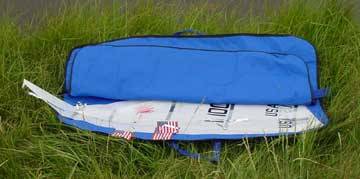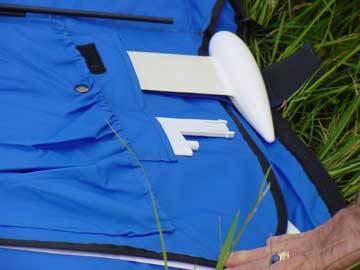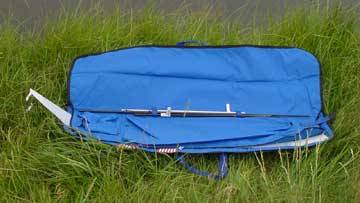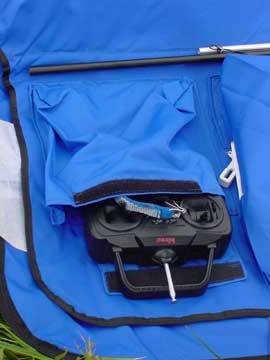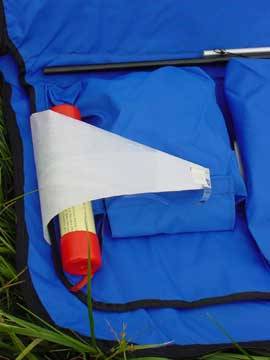Boat In A Bag 101
Yes, there is a right, and a “not so right”, way to pack your boat in your handy carry bag.
To pack and unpack the bag, lay it logo side down, and unzip the bag.
Sails
Pack the sails first since the weight of the other items packed in the center flap makes it difficult to insert the sails. Flip the center flap up and place sails with the luff of the sail in first, the foot of the sail to the right, and the head of the sail to the left (that leaves the leech of the sail with the sail streamers closest to you, and the zipper).
Put the tack of the sail all the way in to the back of the pocket so that the clew of the sail is comfortably inside the zipper. Lay sail flat with no folds. If you have the A sail, it will stick out the left end of the bag – we will get to that later. Before folding the flap over the sail(s), carefully fold the wind streamers back over the sails to keep them from getting caught in the zipper. Now fold the flap down over the sails and check again to make sure no sail, strings, streamers are sticking out that could get caught in the zipper.
Keel
On the right side of the center flap are two long thin pockets. The one closest to the fold of the bag is for the keel, that’s the pocket with the large retention Velcro strap. ALWAYS insert keel fin into the pocket with the pointed end (trailing end) of the lead, pointing toward you (away from fold in bag) The lead is soft so it is important to protect the pointed end from receiving a blow. The strap folds over the lead and attaches with Velcro.
Rudder
Goes in the shorter of the two pockets – right next to the keel.
Hull
Remove the battery pack before packing hull. The hull is inserted into the large pocket UPSIDE DOWN and STERN FIRST. (I know, I know – different from the video – but this is the best way) When fully in the pocket, the tiller will stick out through the hole in the left end of the pocket. In the middle of the elastic opening for the hull pocket is a snap (newer bags only). After the boat is inserted, clip the snap shut so that the bow of the boat is held toward you (away from the keel lead). This snap helps keep the hull from banging on the point of the lead.
Spars
In the fold of the bag are two Velcro strap keepers (newer bags only). Take your mast sections, and the boom and secure them with the straps. Even the A mast will fit right along with your standard mast and boom. If you do not have these Velcro strap keepers, you will find the spars will still ride properly in this location.
Transmitter, batteries, etc.
To the left of the hull pocket is the transmitter pocket. Insert the radio BOTTOM FIRST into the pocket with the control sticks FACING UP. You should remove the batteries from the boat and put in this pocket as well. This keeps the heavy batteries from getting loose inside the boat and banging around. You should also find room in this pocket to put other small items like sun tan lotion, etc.
Stainless Steel Cradle
If you have this boat stand, fold it flat and then put the open ends around the stern of the hull with the cross beam between the stern of the hull and the radio pocket, and the curved end around the outside of the radio pocket. It fits perfectly if you do it right – not worth a darn if you do it wrong. You’ll see.
A sail
If you have the A sail, you will now fold the head of the sail back across the radio compartment. I recommend that you insert a small piece of foam, or use the wind vane storage tube, to fold the sail over to keep it from getting a hard crease in the sail. Be careful when zipping the bag that the sail does not get caught in the zipper.
Shipping
If you are going to ship your boat or check it as baggage on an airplane (which I have done countless times with no damage) these extra packing tips are worthwhile.
Remove the 8 batteries from the transmitter. They can be stored in the transmitter pocket in a zip lock bag or similar. The momentum of the batteries left in the transmitter often smashes the compression clips at the end of the battery trays. Even though not permanently damaged, you must pry these clips out or you will end up with intermittent power in the transmitter. Better to remove batteries for shipping.
Use waded newspaper or other packing, to fill in the ends of the bag. Especially pay attention to packing between the radio pocket and the stern of the boat. A hard shift of the boat that strikes the tiller on the radio, can cause the gears in the steering servo to be damaged. It is also recommended that a rubber band be looped on one of the steering wires and then looped over the hatch. This holds the tiller hard over in one direction, which also minimizes the chance of gear damage.
Also, plenty of packing around and over the radio is important. A real squash of the bag can jam (and break) the control sticks on the face of the radio.
On the other end, pack well around the keel lead to keep it insulated from contact with the outside of the bag and the bow of the boat. A foam or cardboard piece fitted around the pointed keel lead is a good choice.
The bottom line is to fill the open spaces in the ends of the bag and you will be amazed at the pounding this boat and bag can take.
Pack the bag, with the boat inside, in the bag shipping box. Even though the box does not do much to protect the boat and contents from impact, it does keep the bag from getting scuffed up. Note: If you cut the tape on this bag box, it lies completely flat for storage, and yet when you need it, it only takes a little tape to reuse it over and over.
Enjoy this terrific boat in its special carrying case and learn to take it with you everywhere you go, because you can.
This article was written by Steve Lang of SailRC.com.

